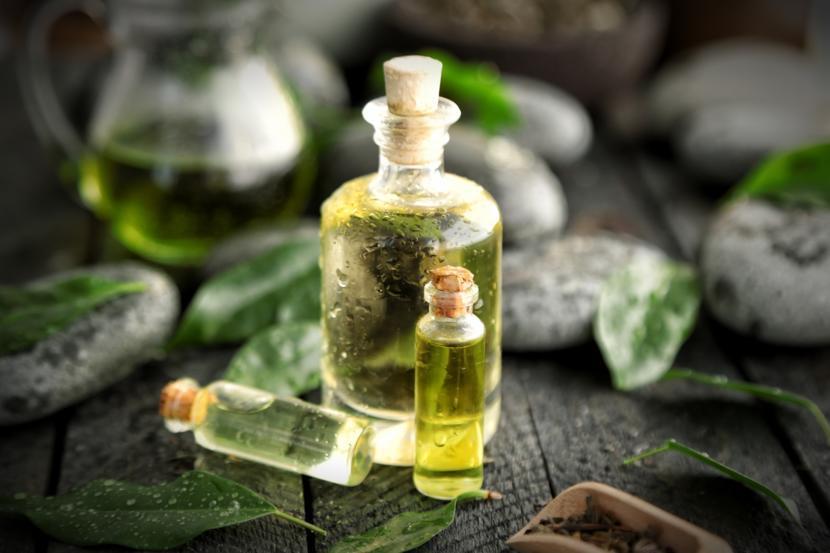The Many Benefits of Tea Tree Oil

You might have noticed that many beauty and health care products such as creams, shampoos, lotions, and face wash formulas have tea tree extracts as their main ingredient. This amazing essential oil is extensively used in many products because of its numerous benefits to the skin, hair, and general health and wellness. Most recently it has been designated as a treatment for a number of skin ailments such as acne and psoriasis. So, if you frequently have skin concerns, make sure to have a good stock of tea tree oil in your cabinet. This article will put some light on this wonder of this oil, its uses, benefits, and more.
What is tea tree oil?
Tea tree oil or melaleuca oil is an essential oil made from the leaves of Melaleuca alternifolia, an Australian native plant. It is a yellow-colored oil known for its antiseptic and purifying qualities. Hence, it is mainly used for purifying the air, cleaning home surfaces, washing skin, and promoting a healthy immune function. Tea tree oil contains more than 92 different compounds and has unlimited applications.
For several centuries, Aboriginal Australians have been using the melaleuca tree leaves for treating various ailments. They inhale the oil by crushing the leaves to promote sensations of clear breathing. They also apply the leaves directly to the skin for a cooling effect. They prepare tea and antiseptic poultices by boiling its leaves and using them to treat wounds, cuts, and other skin infections.
According to a legend, the Aborigines used to create a tea tree oil pool called as the "magic lagoon" to heal their cuts, wounds, burns, and skin disorders. The melaleuca trees surrounded the pool. When leaves fell into the pool, it created a miraculous, natural healing bath.
Melaleuca is frequently used for cleansing and purifying the skin because of its compounds. As such, it supports a healthy skin complexion. It can also be used in homes to clean surfaces and as a protection against environmental threats. Tea tree oil is also often used for soothing skin irritations.
You need not travel all the way to Australia to get tea tree oil. The positive effects of these trees are now available in the form of essential oils packed in bottles. You can visit your nearby medical, organic store or health food store to buy this essential oil.
What are the most popular uses for tea tree oil?
1) Tea tree oil for lice
Tea tree oil is one of the most effective remedies for treating head lice. If you, your child, or anyone in the family has a head lice infestation, you can use this essential oil to get effective results. Moreover, unlike other medical treatments in the market that can also hurt your scalp and damage your hair, tea tree oil is free from any potential side effects. Head lice are contagious. They can transfer from the head of one person to another by sharing hats, combs, pillows, or touching heads. Hence, it becomes even more important to remove these nasty creatures that often act as a reason for embarrassment.
Tea tree oil has two major elements: 1,8-cineole and terpinen-4-ol. These elements are known to have insecticidal properties, especially in killing head lice. The tiny eggs of lice known as "nits" are firmly attached to the hair shaft, making them difficult to remove. Tea tree oil dissolves the glue-like substance that makes the nits strongly attached. Applying tea tree oil makes it easier to remove the nits while combing. Since tea tree oil has a very strong smell, it inhibits the lice from transferring from one person to another, preventing further infestation.
Although using tea tree oil for lice is safe most of the time, a very small percent of people have reported an allergy to it. If you experience any kind of irritation or sensitivity after applying tea tree oil on your scalp for head lice, discontinue using the oil and speak to your your doctor. The doctor can recommend alternate options to treat head lice infestation.
2) Tea tree oil for toenail fungus
Toenail fungus is a very common fungal problem. Also known as "onychomycosis", this condition is often caused when moisture gets trapped in warm conditions, which is a perfect environment for the fungus to thrive. A nail fungal infection is characterized by a yellow or white-colored spot beneath the tip of your toenail. It may also affect multiple toenails and causes discoloration as well as thickening of the nails. In severe cases, it may be painful and may affect the ability of a person to use his feet.
The rich medicinal value and antiseptic properties of tea tree oil make it an ideal remedy for fighting off infections. This essential oil is also known for its antibiotic properties that help in warding off health problems such as skin infections, cuts, wounds, burns, and much more. Tea tree oil for toenail fungus is as effective as clotrimazole, a medication used for treating nail fungus. If you have a fungal infection on your nails, applying tea tree oil on a regular basis will be extremely helpful for you. Tea tree oil is a natural disinfectant and its antibacterial and fungicidal properties are very helpful in treating a variety of fungal infections. Simply soak a cotton ball with a few drops of tea tree oil and gently apply to the affected nails.
3) Tea tree oil for yeast infection
Yeast infection is caused by Candida albicans, a microscopic fungus that is commonly present in our body. Under healthy conditions, the growth of Candida is usually controlled. However, due to certain factors, the number of Candida species may outweigh the number of good bacteria, which then leads to an infection. Yeast infection most commonly occurs in the vagina, but it can also affect the digestive system, which includes the lower abdomen. Fungal infection can also affect nail beds, beneath the skin the folds, and under the breasts.
Tea tree oil is a very powerful remedy for treating vaginal yeast infections. Tea tree oil contains terpinen–4–ol, which is known to kill the fungus that causes yeast infections. The two other elements it contains are gamma–terpinene and alpha–terpinene, which can also prevent the growth of Candida albicans. The anti-inflammatory properties of tea tree oil help restore the balance of good and bad bacteria in the body. It has antifungal, antibacterial, and antimicrobial properties that help treat yeast infections. You can take advantage of tea tree oil for yeast infection through vaginal douches and oil baths. You can also apply it topically to your vagina. If you prefer to topically apply tea tree oil in or around the vagina, dilute it first with a carrier oil such as coconut oil. Start with a weak concentration of tea tree oil and apply to a small area first. If your body does not negatively react to it, keep increasing the amount. A small concentration of tea tree oil works great with coconut oil for treating a yeast infection because they both have antifungal properties.
4) Tea tree oil for dandruff
Dandruff begins with sebum, the natural oil that our body secretes to keep our skin and hair healthy. This sebum forms a protective layer around the dermis. However, when our body produces this sebum in excess, it leads to acne and dandruff. This is due to the presence of Malassezia, a yeast-like fungus that promotes the excessive growth of skin cells. When these cells die, they become dandruff.
The antifungal properties of tea tree oil also make it a good remedy for treating dandruff. It kills the fungus that causes the overproduction of the skin cells, resulting in white flakes called dandruff. This essential oil has terpinen-4-ol, an element with antifungal and antibacterial properties. When applied on the scalp, it infiltrates the hair follicles, unclogs them, and destroys microorganisms that cause scalp problems such as irritation, itchiness, and dandruff.
Tea tree oil for dandruff is available in both pure and organic forms. However, if you really want to take full advantage of this oil, it is better to go for its purest form. You can find the purest form of tea tree oil from any drugstore. There are several ways of using tea tree oil for dandruff, but one of the easiest ways is by using it along with your regular shampoo. Put a few drops of tea tree oil in your shampoo and start washing your hair. A ratio of 1 drop tea tree oil to 3 mL of shampoo must be followed.
5) Tea tree oil for cold sores
If you have been experiencing cold sores, you know how irritating it can be. It's quite difficult to deal with cold sores because they are among the most irritating and uncomfortable skin infections. They not only painful but can be a source of embarrassment. Tea tree oil is one of the most effective remedies used for treating cold sores.
Cold sores are mainly caused by HSV-1 or herpes simplex virus type 1. There are many essential oils you can use to treat them, but tea tree oil is counted among the best remedies for this type of skin problem. It helps you get rid of cold sores and pain much faster. Using a cotton swab, apply tea tree oil directly on the cold sore for 3-4 times a day. However, avoid getting it in your mouth as it is toxic. Gently apply the oil to the sores. If you are using it for the first time, apply it to just one sore and wait for a few minutes. If skin irritation occurs, discontinue using it.
6) Tea tree oil for skin
If you often suffer from skin problems such as acne, blemishes, and dark spots, put a few drops of tea tree oil on a cotton swab and directly apply it on the affected areas of your skin. Many gels, face wash formulas, and creams also contain pure tea tree oil. Using harsh chemicals and medications can be bad on your skin. It is much better to treat using a tea tree oil remedy instead.
You might also have noticed various anti-acne skin creams that contain tea tree extracts. According to studies, tea tree oil is as effective as benzoyl peroxide in reducing acne. It is a natural substitute for curing acne with no potential side effects such as skin peeling and redness of the skin. It also reduces the production of sebum by the skin and kills the bacteria that cause acne. Tea tree oil is a wonderful skin treatment, especially for oily and acne-prone skin.
It can also be used as a moisturizer for dry skin. Just mix 5 tablespoons of tea tree oil to 1 tablespoon of almond oil and gently massage it onto your skin. After some time, take a bath as you would normally do. The regular use of tea tree oil will help you keep your skin moisturized and hydrated for a longer time. By using tea tree oil, your skin will feel suppler, softer, and more glowing.
7) Tea tree oil for hair
Tea tree oil promotes hair growth. It penetrates hair follicles, unclogs them, and nourishes your roots. It can get rid of head lice, dandruff, dry scalp, and other types of hair problems. Apart from that, it prevents hair fall too. Well, who doesn’t want thick and long hair? Tea tree oil prevents hair fall and provides an added layer of protection to your hair. It restores all the needed nutrients for your hair, making it look softer and shinier.
Tea Tree Oil vs. Tea Tree Oil Shampoo
Tea tree oil in its purest form is concentrated extract. Applying it directly on your scalp can be helpful, but it can cause irritation in some people. Tea tree oil shampoo, on the other hand, has a lesser concentration of tea tree oil. Its result may not be as effective as compared to its purest form, but it is usually safer to use.
Tea tree oil is definitely one of the most effective essential oils used for treating a variety of ailments. Use it wisely on your skin, scalp, and hair to reap its benefits.














